The Acrylic Emulsions Market is estimated to be valued at USD 13.2 billion in 2025 and is projected to reach USD 27.8 billion by 2035, registering a compound annual growth rate (CAGR) of 7.7% over the forecast period.
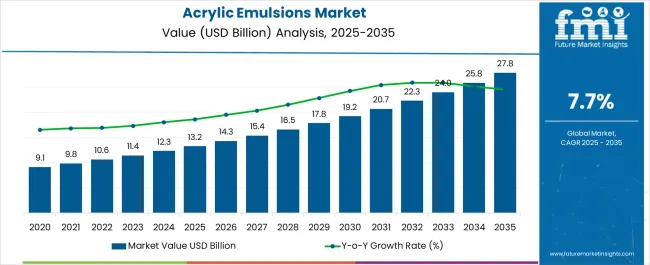
| Metric | Value |
|---|---|
| Acrylic Emulsions Market Estimated Value in (2025 E) | USD 13.2 billion |
| Acrylic Emulsions Market Forecast Value in (2035 F) | USD 27.8 billion |
| Forecast CAGR (2025 to 2035) | 7.7% |
The Acrylic Emulsions market is showing strong growth momentum, driven by increasing demand across construction, automotive, packaging, and industrial applications. Rising urbanization and infrastructure development projects in emerging economies are fueling demand for high-performance coatings, adhesives, and sealants that rely heavily on acrylic emulsions. Their properties such as durability, weather resistance, flexibility, and low volatile organic compound content are making them an eco-friendly alternative to solvent-based formulations, aligning with global sustainability goals.
The market is also being shaped by increasing regulatory pressure to adopt water-based and environmentally safe products, further boosting acrylic emulsion usage. Advancements in polymerization technology are enabling manufacturers to develop tailor-made emulsions with enhanced performance, meeting the specific needs of diverse industries.
Furthermore, the rapid growth of the paints and coatings industry, coupled with demand for architectural finishes and automotive refinishes, is supporting expansion As companies emphasize cost efficiency, performance reliability, and compliance with environmental standards, the Acrylic Emulsions market is expected to witness sustainable growth across both developed and developing regions in the coming years.
The acrylic emulsions market is segmented by product type, application, and geographic regions. By product type, acrylic emulsions market is divided into Pure Acrylic and Polymer & Co-polymer. In terms of application, acrylic emulsions market is classified into Paints & Coatings, Construction Additives, Adhesives & Sealants, Paper Coatings, and Others. Regionally, the acrylic emulsions industry is classified into North America, Latin America, Western Europe, Eastern Europe, Balkan & Baltic Countries, Russia & Belarus, Central Asia, East Asia, South Asia & Pacific, and the Middle East & Africa.
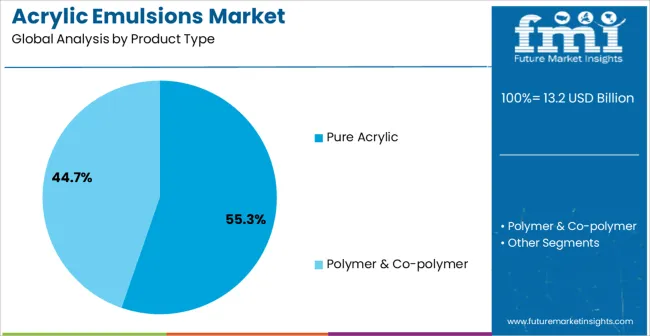
The pure acrylic product type segment is projected to hold 55.3% of the Acrylic Emulsions market revenue in 2025, establishing itself as the leading product category. This leadership is primarily attributed to the superior properties of pure acrylics, including strong adhesion, weather resistance, and durability under harsh environmental conditions. Their ability to provide long-lasting protection against ultraviolet degradation and moisture penetration makes them highly preferred in architectural coatings and exterior applications.
Pure acrylics are also widely used in industrial coatings, adhesives, and textiles due to their flexibility and compatibility with diverse substrates. The increasing preference for water-based formulations has further strengthened demand for pure acrylic emulsions, as they align with regulatory standards promoting low-VOC and eco-friendly products.
Rapid construction activity in emerging economies, combined with demand for sustainable building materials, continues to reinforce their market dominance As technological advancements enhance product customization and performance, pure acrylic emulsions are expected to remain a key driver of growth, maintaining their position as the most widely adopted product type.
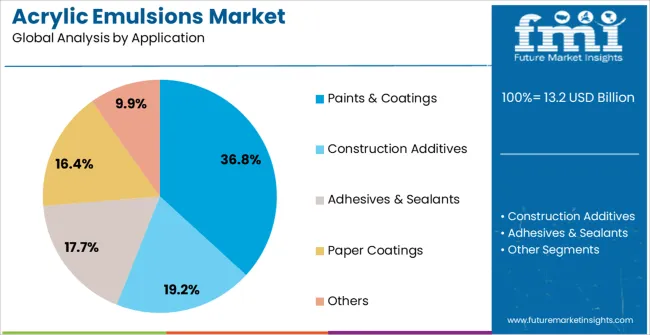
The paints and coatings application segment is anticipated to account for 36.8% of the Acrylic Emulsions market revenue in 2025, highlighting its role as the leading application area. Growth in this segment is being fueled by rising demand for high-performance architectural and industrial coatings that offer superior durability, weatherability, and aesthetic appeal. Acrylic emulsions in paints and coatings deliver benefits such as quick drying, color retention, and resistance to cracking and peeling, making them ideal for exterior and interior applications.
The rapid expansion of the construction and automotive industries, coupled with growing consumer demand for eco-friendly, water-based formulations, is reinforcing this trend. In addition, regulatory mandates limiting the use of solvent-based coatings are encouraging widespread adoption of acrylic emulsions in paints and coatings.
Manufacturers are increasingly focusing on developing advanced acrylic formulations that provide enhanced functionality, including stain resistance and dirt pickup resistance With infrastructure growth, rising renovation activity, and continued emphasis on sustainable solutions, paints and coatings are expected to remain the dominant application area for acrylic emulsions globally.
Acrylic are the esters of acrylic acid and are formed from the reaction between acrylic acid and alcohol whereas emulsion are the colloidal suspension of a fluid in another fluid primarily in oil and water. Pure acrylic emulsions are broadly used in the preparation of a number of end-use products. Which includes architectural coatings, building materials, industrial coatings, glass-fiber secondary binders for tissues and veils.
Water borne acrylic emulsions creates high performance coatings for various end use industries such as, printing ink, paper making and many more. Recently manufacturers are focusing on to provide advance technologies for the acrylic emulsions market as they providing more advanced formaldehyde free technologies or self -cross linking and also to focus on raw material selection for the acrylic emulsions.
Properties of the acrylic emulsions plays a key role in the improvement of the quality such as it provides better coalescing properties than others. Growing responsiveness in regard with the hostile effects of VOC emissions, which is a primarily present in the solvent based goods, this has increased the demand for acrylic emulsion.
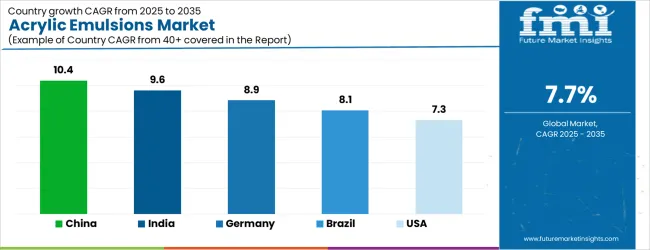
| Country | CAGR |
|---|---|
| China | 10.4% |
| India | 9.6% |
| Germany | 8.9% |
| Brazil | 8.1% |
| USA | 7.3% |
| UK | 6.5% |
| Japan | 5.8% |
The Acrylic Emulsions Market is expected to register a CAGR of 7.7% during the forecast period, exhibiting varied country level momentum. China leads with the highest CAGR of 10.4%, followed by India at 9.6%. Developed markets such as Germany, France, and the UK continue to expand steadily, while the USA is likely to grow at consistent rates. Japan posts the lowest CAGR at 5.8%, yet still underscores a broadly positive trajectory for the global Acrylic Emulsions Market. In 2024, Germany held a dominant revenue in the Western Europe market and is expected to grow with a CAGR of 8.9%. The USA Acrylic Emulsions Market is estimated to be valued at USD 4.9 billion in 2025 and is anticipated to reach a valuation of USD 4.9 billion by 2035. Sales are projected to rise at a CAGR of 0.0% over the forecast period between 2025 and 2035. While Japan and South Korea markets are estimated to be valued at USD 682.5 million and USD 387.6 million respectively in 2025.
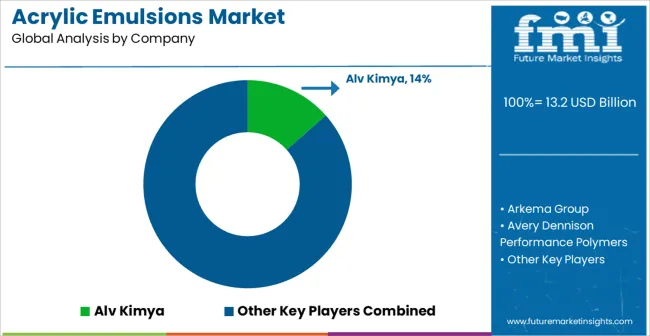
| Item | Value |
|---|---|
| Quantitative Units | USD 13.2 Billion |
| Product Type | Pure Acrylic and Polymer & Co-polymer |
| Application | Paints & Coatings, Construction Additives, Adhesives & Sealants, Paper Coatings, and Others |
| Regions Covered | North America, Europe, Asia-Pacific, Latin America, Middle East & Africa |
| Country Covered | United States, Canada, Germany, France, United Kingdom, China, Japan, India, Brazil, South Africa |
| Key Companies Profiled | Alv Kimya, Arkema Group, Avery Dennison Performance Polymers, BASF, Celanese, Covestro, DIC, Dow Inc, Henkel Additives, H.B. Fuller, Jensen & Nicholson, and Mallard Creek Polymers |
The global acrylic emulsions market is estimated to be valued at USD 13.2 billion in 2025.
The market size for the acrylic emulsions market is projected to reach USD 27.8 billion by 2035.
The acrylic emulsions market is expected to grow at a 7.7% CAGR between 2025 and 2035.
The key product types in acrylic emulsions market are pure acrylic and polymer & co-polymer.
In terms of application, paints & coatings segment to command 36.8% share in the acrylic emulsions market in 2025.






Our Research Products

The "Full Research Suite" delivers actionable market intel, deep dives on markets or technologies, so clients act faster, cut risk, and unlock growth.

The Leaderboard benchmarks and ranks top vendors, classifying them as Established Leaders, Leading Challengers, or Disruptors & Challengers.

Locates where complements amplify value and substitutes erode it, forecasting net impact by horizon

We deliver granular, decision-grade intel: market sizing, 5-year forecasts, pricing, adoption, usage, revenue, and operational KPIs—plus competitor tracking, regulation, and value chains—across 60 countries broadly.

Spot the shifts before they hit your P&L. We track inflection points, adoption curves, pricing moves, and ecosystem plays to show where demand is heading, why it is changing, and what to do next across high-growth markets and disruptive tech

Real-time reads of user behavior. We track shifting priorities, perceptions of today’s and next-gen services, and provider experience, then pace how fast tech moves from trial to adoption, blending buyer, consumer, and channel inputs with social signals (#WhySwitch, #UX).

Partner with our analyst team to build a custom report designed around your business priorities. From analysing market trends to assessing competitors or crafting bespoke datasets, we tailor insights to your needs.
Supplier Intelligence
Discovery & Profiling
Capacity & Footprint
Performance & Risk
Compliance & Governance
Commercial Readiness
Who Supplies Whom
Scorecards & Shortlists
Playbooks & Docs
Category Intelligence
Definition & Scope
Demand & Use Cases
Cost Drivers
Market Structure
Supply Chain Map
Trade & Policy
Operating Norms
Deliverables
Buyer Intelligence
Account Basics
Spend & Scope
Procurement Model
Vendor Requirements
Terms & Policies
Entry Strategy
Pain Points & Triggers
Outputs
Pricing Analysis
Benchmarks
Trends
Should-Cost
Indexation
Landed Cost
Commercial Terms
Deliverables
Brand Analysis
Positioning & Value Prop
Share & Presence
Customer Evidence
Go-to-Market
Digital & Reputation
Compliance & Trust
KPIs & Gaps
Outputs
Full Research Suite comprises of:
Market outlook & trends analysis
Interviews & case studies
Strategic recommendations
Vendor profiles & capabilities analysis
5-year forecasts
8 regions and 60+ country-level data splits
Market segment data splits
12 months of continuous data updates
DELIVERED AS:
PDF EXCEL ONLINE
Acrylic Paint Market Forecast and Outlook 2025 to 2035
Acrylic Fibre Market Size and Share Forecast Outlook 2025 to 2035
Acrylic Polymer Market Size and Share Forecast Outlook 2025 to 2035
Acrylic Resin Market Size and Share Forecast Outlook 2025 to 2035
Acrylic Fine Particle Market Size and Share Forecast Outlook 2025 to 2035
Acrylic Boxes Market Size and Share Forecast Outlook 2025 to 2035
Acrylic Paper Market Size and Share Forecast Outlook 2025 to 2035
Acrylic Pad Market Size and Share Forecast Outlook 2025 to 2035
Acrylic Adhesives Market Growth - Trends & Forecast 2025 to 2035
Acrylic Teeth Market Trends and Assessment for 2025 to 2035
Acrylic Styrene Acrylonitrile (ASA) Resin Market- Growth & Demand 2025 to 2035
Key Companies & Market Share in the Acrylic Airless Bottle Sector
Analyzing Acrylic Boxes Market Share & Industry Leaders
Acrylic Acid Market Growth - Trends & Forecast 2024 to 2034
Acrylic Airless Bottle Market Trends - Demand & Forecast 2024 to 2034
Acrylic Colors Market
Acrylic Container Market
Acrylic Lenses Market
Acrylic Foam Tapes Market
Cast Acrylic Sheets Market Size and Share Forecast Outlook 2025 to 2035

Thank you!
You will receive an email from our Business Development Manager. Please be sure to check your SPAM/JUNK folder too.
Chat With
MaRIA